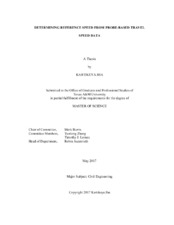| dc.description.abstract | Standard industry and research practice in the area of transportation system performance measurement utilizes reference travel speed as benchmark for calculation of delay, mobility and reliability indices. These reference speeds reflect free-flow (unconstrained) travel conditions on different facilities (freeways, arterial streets, etc.). However, the rationale behind the choice of this important parameter is still not entirely established. An average driver’s perception of reference speed on a roadway segment is influenced not only by the posted limit but also a few other factors including road geometry and driving conditions. Therefore, deriving applicable reference speeds from actual travel time data may be superior to the use of a reference speed value based solely on a fixed posted speed limit. The posted speed limit may not be reflective of current operational conditions on roadway segments.
This research investigates an appropriate reference time window representative of free-flow conditions by analyzing all-day travel patterns. This was done for both uninterrupted flow facilities (interstates and freeways) and interrupted flow facilities (major and minor urban arterials) because of their inherent differences in travel behavior and characteristics. Using probe-based travel time data from INRIX®, a private sector data provider, the analysis incorporated different urban areas in order to provide a more balanced representation of travel patterns and minimize any sampling bias.
It is found that nighttime hours provide a good representation of unconstrained travel and reference speed on both interrupted and uninterrupted flow facilities excluding minor arterial streets. Various temporal windows are examined and based on data availability and variability considerations, the 85th percentile speed during 9PM-6AM overnight hours is recommended as reference speed on all uninterrupted flow facilities and major arterial streets. On facilities with sparse traffic and inadequate data during these nighttime hours, mid-day (11AM-4PM) data should be used in place of nighttime hours to derive reference speed. On minor arterial streets, occurrences of actuation and priority treatment cause nighttime hours to concede lower travel speeds and for such facilities, the 85th percentile of mid-day (11AM-4PM) data is better representative of reference travel conditions. Inclusion of weekend travel data does not significantly impact derived reference speeds. | en |


